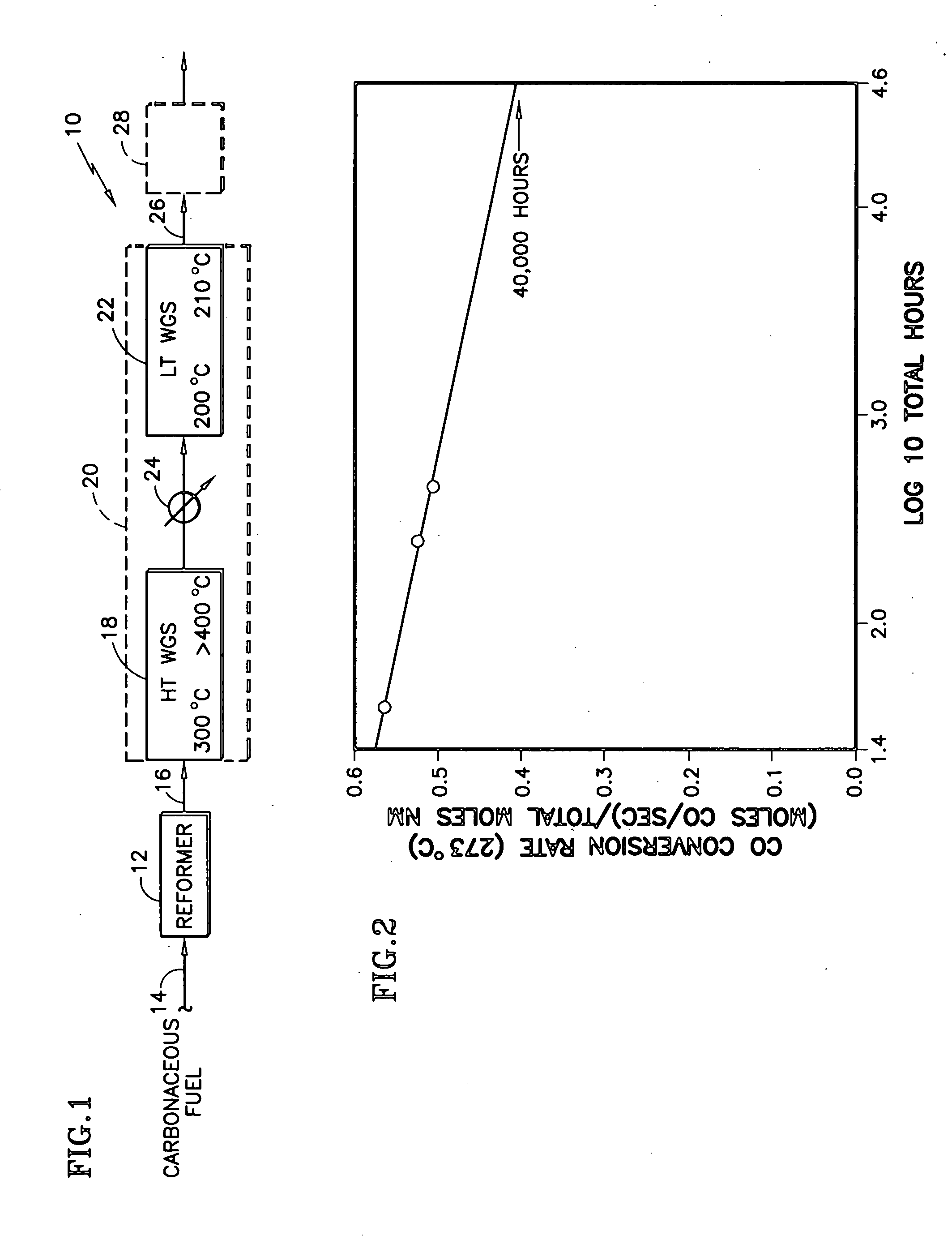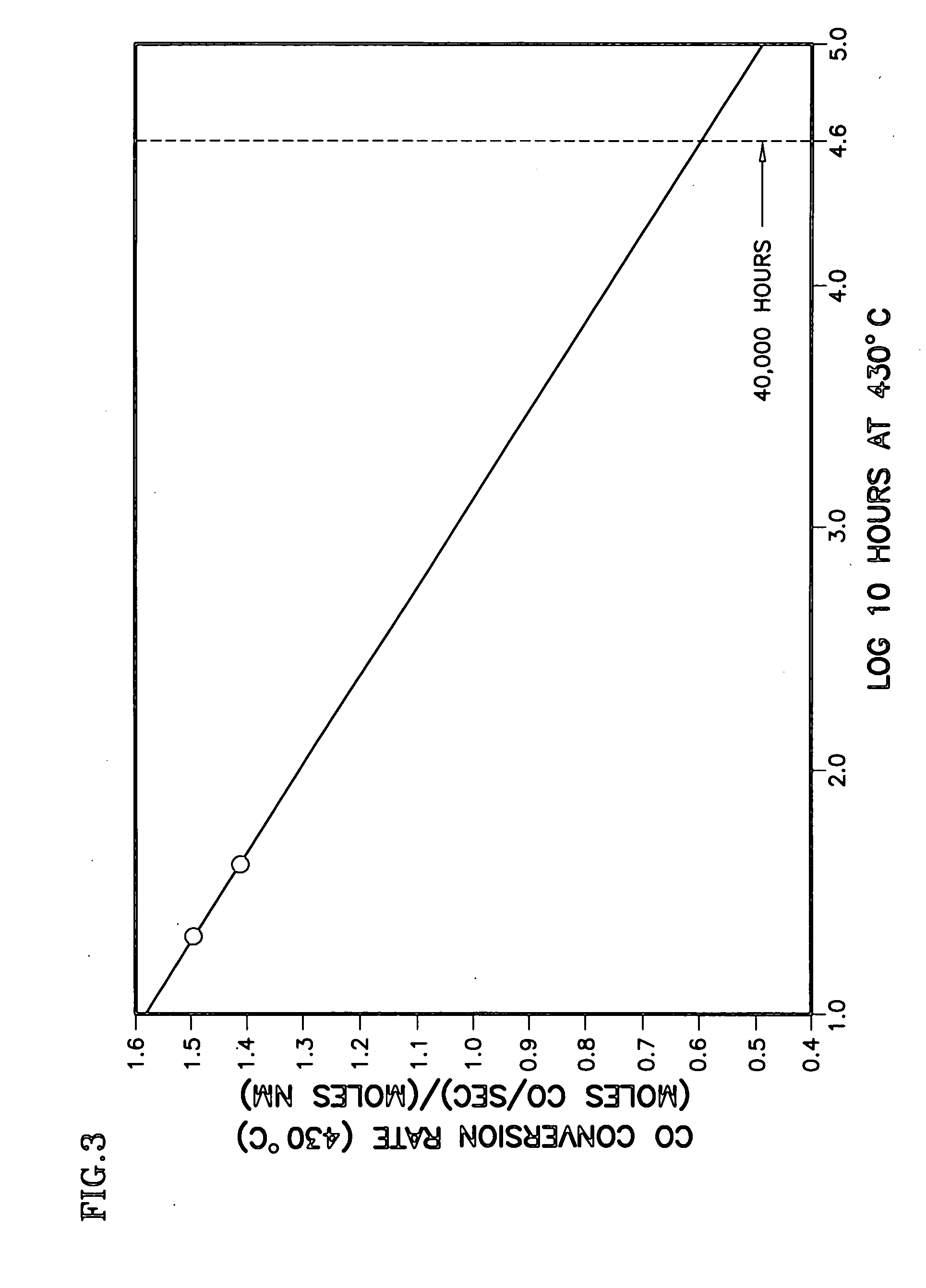[0015] The decline in activity was attributed by the inventors primarily to a loss of low temperature reducibility. Significantly, it was then further hypothesized that the primary cause for the high temperature deactivation is the loss of one of the pathways of the complex
water gas shift mechanistic network. In that regard, it is believed that under high temperature, high CO concentration feed over the
cerium-
zirconium (and / or
hafnium) oxide, a large fraction of the Ce ions get reduced to the Ce+3 state from the Ce+4 state, but the lattice structure retains its essential cubic
fluorite structure. Initially, the presence of a high proportion of Ce+3 ions keeps the number of
oxide ion vacancies high and maintains sufficient oxide
ion conductivity that fosters the type of
water gas shift mechanism described in the aforementioned Bunluesin, et al article. That mechanism may operate in parallel with a
formate-type process such as described in the aforementioned Shido, et al article. It is the Bunluesin type mechanism that, in effect, allows oxide ions to
attack CO molecules chemisorbed on the
noble metal.
[0017] Against this hypothesized basis for the decline in WGS activity of the ceria-containing, mixed-metal oxide under high temperature operation under highly reducing conditions, the invention proposes to mitigate the problem through the addition of one or more dopants having appropriately sized cations with the proper range of accessible oxidation states that will disrupt this oxide
ion vacancy ordering, and thus preserve the overall catalyst activity. It has been found that a group of metal ion constituents having the desired characteristics for disrupting the oxide vacancy ordering consists of
tungsten (W),
niobium (Nb),
tantalum (Ta),
molybdenum (Mo),
uranium (Ur) and
thorium (Th). Because Ur and Th are environmentally objectionable, the group is practically limited to W, Nb, Ta, and Mo. Of that group, W has been found to be particularly effective as a dopant in attaining the durability of the metal oxide as a WGS catalyst under elevated operating temperatures, though combinations of W with Nb, Ta, and / or Mo are also believed to effective. While the literature on
cerium oxide discusses at length rare-earth dopants and alkaline earth dopants, there has been little or no focus on these group 5 and group 6 elements. While W is perhaps the preferred dopant, the optimal choice of dopant, or dopants, and dopant concentration is a complex function of the projected catalyst
operating environment, especially with respect to the partial pressures of the gases, H2O, CO, H2 and CO2 expected and the temperature range the catalyst is expected to encounter. The effective range of
tungsten, provided it is incorporated as a dopant in the crystallites of the ceria-containing,
zirconium /
hafnium-mixed metal oxide and expressed as atomic fraction of cations, is between about 0.05 and 0.15, and is preferably between about 0.07 and 0.12, and is most preferably between 0.09 and 0.11. The most preferable amount or quantity of these oxide ion ordering disruptors is a function of and determined by, the absolute cation fraction of Ce, the Zr / Hf ratio, and the operating conditions including temperature and the feed
gas composition. When the oxide
atomic composition is expressed as Ce[1−(x+y)]MxDpyO2, the sum of x+y can vary from about 0.35 to 0.7 but y is typically in the range of 0.05 to 0.15. M is Zr, Hf or a mixture of both. Hf is preferred, but because of cost and other considerations Zr is acceptable. Dp is one or more of the above-mentioned dopants. The inclusion of one or more of the above-mentioned dopants has been shown to significantly slow the loss of activity, such that the effective life of the WGS catalyst is relatively extended, even under conditions of increased operating temperatures that exceed 310-350° C. and may be in the range of 400-425° C. or above.
[0020] The invention relates also to the process for making mixed metal oxides having the constituents and properties described above, and further, to the use of such mixed metal oxides as catalysts for processing carbonaceous fuels at elevated temperatures, as in water gas shift reactions occurring in temperatures typically exceeding about 350° C. and up to about 425° C. More particularly, the invention relates to the process for making such mixed metal oxides having the constituents of Ce, Zr and / or Hf, and W and / or Mo, as well as the process for making mixed metal oxides having the constituents of Ce, Zr and / or Hf, and Ta and / or Nb. The process for making the ceria-containing mixed metal oxide having the oxide ion vacancy-ordering inhibitor is generally similar to that described in the '808 application, with some modification of the manner in which the constituents are initially combined prior to
precipitation. The process generally includes the steps of 1) dissolving salts of the
cerium and the
zirconium and / or
hafnium to form a metal
salt solution; 2) creating an
aqueous solution containing the oxide ion vacancy-ordering inhibitor (eg., Mo, Nb, Ta, and / or W); 3) creating an
aqueous solution containing
urea, either as a separate solution or in combination with the cerium-containing solution; 4) heating the respective solutions to the appropriate temperature, typically 70° C. or above for that solution; 5) combining the solutions, which for the W and / or Mo oxide ion vacancy-ordering inhibitor comprises 5A) carefully (ie, slowly) combining the
aqueous solution containing the oxide ion vacancy-ordering inhibitor with the cerium-containing solution, and for the Ta and / or Nb oxide ion vacancy-ordering inhibitor comprises 5B) initially combining the cerium-containing solution slowly with the oxide ion vacancy-ordering inhibitor solution to avoid
turbidity and subsequently adding quickly the separate
urea solution; 6) heating the combined solutions to boiling to coprecipitate homogeneously a nano-crystalline mixed-oxide of the cerium, the zirconium and / or hafnium, and the one or more other constituent(s) that at least include the oxide ion vacancy-ordering inhibitor; 7) optionally maturing, if and when beneficial, the coprecipitate in accordance with a thermal schedule; 8) replacing water in the solution with a water miscible, low surface-tension
solvent, such as dried 2-
propanol; 9)
drying the coprecipitate and
solvent to remove substantially all of the
solvent; and 10) calcining the dried coprecipitate at an
effective temperature, typically moderate in the range of 250° C. to 600° C., for an interval sufficient to remove adsorbed species and strengthen the structure against
premature aging.
[0022] Alternatively, the process that incorporates Nb and / or Ta generally includes the steps of 1) dissolving salts of the cerium and the zirconium and / or hafnium to form a metal
salt solution; 2) creating an aqueous solution containing the oxide ion vacancy-ordering inhibitor (eg. Nb and / or Ta); 3) creating a separate aqueous solution containing urea; 4) heating, with constant stirring, the respective cerium, zirconium and / or hafnium and the oxide ion vacancy-ordering inhibitor (eg. Nb and / or Ta) solutions to about 70° C. and the urea solution to, or nearly to, boiling; 5) adding the hot, 70° C., solution of Nb and / or Ta slowly to the solution of cerium, zirconium and / or hafnium to minimize the
turbidity of the combined Ce, Zr and / or Hf, and Nb and / or Ta solution; 6) adding the hot, at least 92° C., preferably just boiling, solution of urea quickly to the metal solution; 7) raising the temperature of the combined solution to 100° C. to crystallize / coprecipitate the oxide from solution; 8) after oxide
crystallization /
precipitation is observed, optionally maturing, if and when beneficial, the coprecipitate in accordance with a thermal schedule; 9) washing the coprecipitated nano-
crystalline oxide with water; 10) replacing water in the solution with a water miscible, low surface-tension solvent, such as dried 2-
propanol; 11)
drying the coprecipitate and solvent to remove substantially all of the solvent, optionally under vacuum; and 12) calcining the dried coprecipitate at an
effective temperature, typically moderate in the range of 250° C. to 600° C., for an interval sufficient to remove adsorbed species and strengthen the structure against
premature aging.
 Login to View More
Login to View More 


